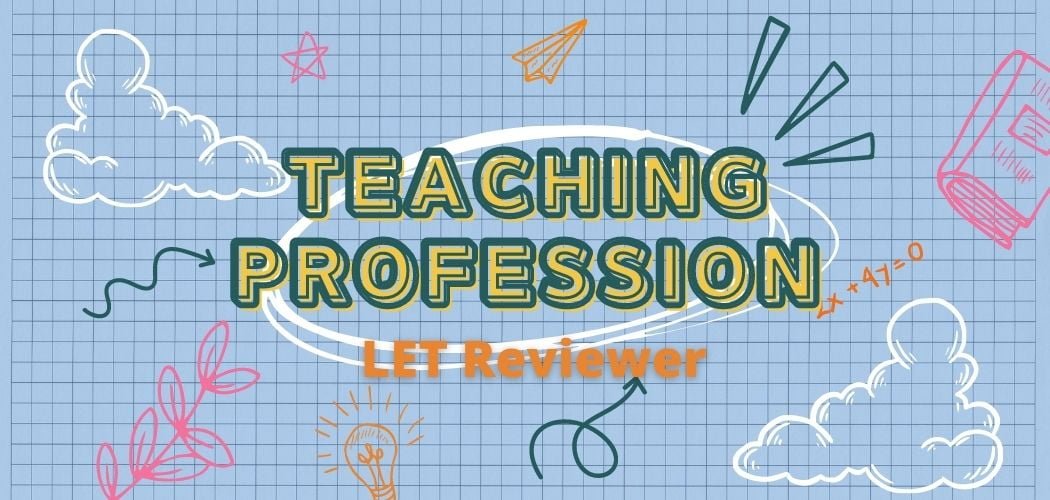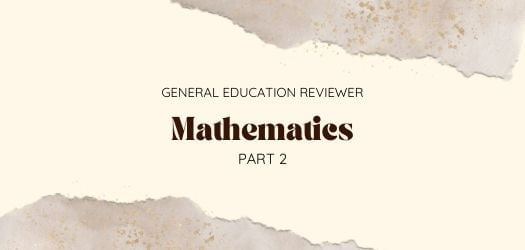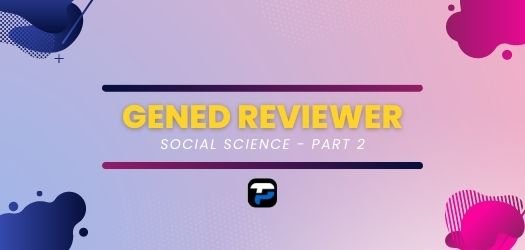Aspiring teachers in the Philippines seeking to pass the Licensure Exam for Professional Teachers, or LEPT/LET have access to our FREE test resources.
TestPinoy created these full-blown mock test reviewers to determine whether or not you have the knowledge necessary to be an entry-level educator in the Philippines school system. This practice exam assesses your general and specific knowledge to become a certified educator within the country.
Explore our full-blown simulation test to get started on the path to your new teaching career. You can either take the quiz using Google form (ads free) so you can take the practice test or download the PDF file (well-formatted).
Recommended reading
- 13 Tips From Repeaters: How to Pass the LET the First Time
- 5 Researched-Based Techniques to Pass the LET
- How to Remember Better: A Study Tip
Prof Ed LET reviewer
Bonus: A full mock exam (150 items) using Google Quiz is also available to get immediate feedback or download the PDF file (both links are available at the end of this section).
Question 1. Which among the following situations is PROHIBITED under the Code of Ethics for Professional Teachers?
A. Cordial relationship with parents
B. Living with dignity at all times
C. Tutorial fees from learners in their class✅
D. Upholding the highest standards of living
Question 2. What is the basic characteristic of the Performance Appraisal System for Teachers?
A. Criteria-assessed
B. Peer-supportive
C. Self-directed
D. Competency-awarding✅
Question 3. Based on what is written in the Bible, who was the Jewish teacher who ought to use stories or parables to bring out lessons in life?
A. St. Paul
B. Isaiah
C. Jesus✅
D. Moses
Question 4. According to RA 4670, the official number of hours spent in school by teachers should be:
A. 8 hours✅
B. 6 hours
C. 12 hours
D. 10 hours
Question 5. Which among the students below supports the idea that the Philippine education system is community-centered?
I. Encouragement of local initiative
II. Community values reflected in the education program
III. Fiscal support through congressional legislation
IV. Children, adults, and out-of-school education in the community
A. I, II, and IV✅
B. I, III, and IV
C. II, III, and IV
D. I, II, III, and IV
Question 6. One of the principles of learners says that “Each learner approaches the world in many ways”. How can this be applied especially in a multicultural classroom?
A. Varied learning experience
B. Standard lesson plan✅
C. Outcome-based syllabus
D. Multigrade teaching
Question 7. What appropriate intervention did DepEd implement to resolve school children’s population density in public schools?
A. Tapping NGOs who assist schools
B. Evening vocational classes for drop-outs
C. Morning and afternoon sessions✅
D. Development of instruction materials
Question 8. In joining different programs for personal growth and professional development, what is the most desirable drive that is expected from the teachers?
A. Higher position according to the set merit system
B. Stature as a degree holder in education
C. Aspiration to become a master teacher
D. Intrinsic desire to grow continuously✅
Question 9. Teacher Jenny adheres to the idea that her students do not need to know the interactive learning outcomes of her lessons. She proceeds to the learning activities without letting them know what they were supposed to learn today. What principle of learning does Teacher Jenny violate?
A. Learning is the discovery of the personal meaning of ideas.
B. Learning is an active process
C. Learning is a cooperative and collaborative process
D. Effective learning begins with setting clear expectations and learning outcomes✅
Question 10. Teacher Jhera asks her learners to see the link and relevance of their new lesson to their personal experience and share the same with the class. Therefore, Teacher Jhera supports which principle of learning?
A. Learning is an active process
B. Effective learning begins with setting clear expectations and learning outcomes
C. Learning is a cooperative and collaborative process
D. Learning is the discovery of the personal meaning of ideas✅
Question 11. Which among the practices below should Teacher Jess implement to demonstrate that the behaviorist philosophy of education works well in motivating the students to learn?
A. Non-authoritarian approach to teaching
B. Subject-matter-centered teaching
C. Back to the basics move
D. Use rewards and incentives✅
Question 12. What school of thought is behind the student-centered approach in teaching which emphasizes discovery learning among students?
A. behaviorism
B. progressivism✅
C. essentialism
D. existentialism
Question 13. What best describes “pwede na” mentality vs excellence in service/ work?
A. arduous preparation
B. committed work
C. resignation to mediocrity✅
D. striving to be the best
Question 14. There are several components that make up a morally mature person. Which shows that a teacher applies moral principles (e.g., the Golden Rule) when making moral judgments?
A. Encourage others to share their ideas
B. Develops self-esteem
C. Reflects on moral choices✅
D. Takes into account the opinions of others
Question 15. “An ounce of experience is better than a ton of theory” was one of John Dewey’s main contentions. This statement underscores the:
A. need for theory
B. the primary experience✅
C. the need for experience
D. the primacy of theory
Question 16. To lessen the likelihood of students disarranging chairs and to ensure there is no litter on the floor, Teacher Coleen makes sure the classroom is clean and orderly. On which school of thought is her action-based?
A. existentialism
B. behaviorism✅
C. progressivism
D. reconstructivism
Question 17. Your students are more interested in a topic that is not part of your lesson, so you drop your original lesson in favor of what they like. Which governs your decision?
A. rationalism
B. existentialism✅
C. empiricism
D. progressivism
Question 18. What enables the learner to fully contribute to a peaceful and just society based on the “Learning to do” pillar of education?
A. knowledge
B. insight
C. skills✅
D. values
Question 19. A learner must first attain this for him/herself before being able to fully “learn to live and work together”.
A. find peace within oneself✅
B. love his fellowmen
C. attain an altruistic mind
D. become self-actualized
Question 20. If people live together in peace and harmony through understanding one’s traditions and values, what word would describe the situation?
A. Planning phase✅
B. Evaluating the experience
C. Identifying the purpose
D. Organizing the experiences
Question 21. “Learning to learn” is best seen in this skill/s.
A. to ask and gather data
B. to process and select the information
C. to listen and observe
D. to read with understanding✅
Question 22. A powerful European country supplied weapons to Afghanistan rebels who were fighting a war in the Middle East. Based on the principle of moral discernment, what is the most applicable based on this scenario?
A. Principle of double effect
B. Principle of material cooperation
C. Principle of lesser evil
D. Principle of formal cooperation✅
Question 23. The development of sound judgment, commitment to truth, and the strengthening of the moral fabric of society all belong to this major goal of Philippine education.
A. self-realization
B. ethical character✅
C. autonomy
D. enculturation
Question 24. What educational philosophy should a teacher emphasize if he wants his students to develop self-responsibility and accountability?
A. Utilitarianist
B. Existentialist✅
C. Essentialist
D. Constructivist
Question 25. Among the active participation of school officials and teachers in the community, which of the following is not appropriate due to prevailing religious sentiments?
A. Literacy assistance for out-of-school children/youths
B. Household campaign for healthful practice
C. Introducing cooperative thrift practices
D. Promoting contraceptives for planned parenthood✅
Question 26. Transparency International a global corruption watchdog, rates the Philippines as one of the most corrupt nations in Asia. What educational program is relevant to this situation?
A. Values Education
B. Cultural Preservation Program
C. Socio-Economic Development
D. Infrastructure Modernization✅
Question 27. This learning episode includes documentation that is complete, clear, and well-organized.
A. Assignments submitted before the deadline
B. Portfolio✅
C. Analysis of learning episodes
D. Reflections/insight
Question 28. Teacher Rina does not have drills out of context. Instead, she gives real-world Math problems for the learners to drill on. This act of Teacher Rina is rooted in which principle of learning?
A. Effective learning begins with setting expectations and learning of outcomes
B. Learning is the discovery of the personal meaning of ideas✅
C. Learning is an active process
D. Learning is a cooperative and collaborative process
Question 29. Which of the following can help the school to follow the standards of the Total Quality School Model?
A. Clientele-focus
B. Empowerment
C. Continuous improvement✅
D. Involvement of the community
Question 30. To achieve a meaningful teaching-and-learning process, it is best to link and related the lesson to the life of the student by integrating a relevant value in the lesson. Which among the following agrees with this principle?
A. Share lesson objectives/outcomes with students.✅
B. Write SMART lesson objective
C. Lesson objectives/outcomes integrated with 2 or 3 domains-cognitive, skill, and effective learning
D. Begin with the goal/objective in mind.
Question 31. Teacher Ian asks students to break down, critically examine, interpret and investigate a concept or problem. This demonstrates what kind of learning?
A. Synthesis
B. Application
C. Evaluation
D. Analysis✅
Question 32. Among the different types of knowledge, this knowledge is achieved through computer literacy and the knowledge of technology that is most appropriate to be used in teaching.
A. Method knowledge
B. Pedagogical knowledge
C. Technological knowledge✅
D. Content knowledge
Question 33. The following are major needs for the alignment of the curriculum with learning outcomes EXCEPT for_____.
A. clear establishment of learning outcomes
B. teaching-learning activities based on content
C. procurement of cost-effective resources✅
D. assessment to determine the realization of outcomes
Question 34. A bulletin board display has many colors and arrangement that catches and holds interest. What criterion is being exemplified in this situation?
A. balance
B. interactivity
C. utility
D. attractiveness✅
Question 35. Among the activities below, which activity demonstrates collaborative learning?
A. Group project concept and application✅
B. Student group takes drills
C. Student group takes a field trip
D. Teacher tutorial on student groups
Question 36. As a classroom manager, Teacher A required each of his students to stand and give their seatwork individually to him before the bell rings for dismissal. What component of classroom management did he establish?
A. routine✅
B. code
C. norm
D. rule
Question 37. Which among the following is NOT a responsibility of the Learning Resource/Audiovisual/Educational Technology Center of a school?
A. make available technology equipment for use of students and teachers
B. work with teachers in producing instructional materials
C. conduct training for teachers on the use of technology tools
D. accomplish student’s technology projects for them✅
Question 38. This knowledge included the principle and strategies of teaching such as formulating objectives, designing activities, and assessing learning outcomes.
A. teaching knowledge
B. content knowledge
C. pedagogical knowledge✅
D. method knowledge
Question 39. What questioning technique is used by Teacher A when he asked the learners a series of questions that serves to explore, look into, and inquire?
A. repeat
B. rephrase
C. redirect
D. probe✅
Question 40. Which among the criteria below is achieved by a bulletin board display whose objects and design are well-arranged to show stability?
A. interactivity
B. balance✅
C. unity
D. attractiveness
Question 41. In classroom management, this is the immediate and effective way to address three misbehaving students.
A. assign them a separate seat✅
B. detain after class
C. stop classes till three stops misbehaving
D. send them to the guidance room
Question 42. Shy and timid students can be best helped by providing _______.
A. encouragement✅
B. tolerance
C. disciplined guidance
D. persistent counseling
Question 43. In his Math class, Teacher Knoi showed a graph and then asked. “What data is the graph concerned?” rather than “What do you see in the graph?”. With this, what questioning method did he use?
A. evaluative
B. tolerance
C. convergent✅
D. persistent counseling
Question 44. Among the five levels of technology integration, what is achieved by teacher Ruby who directs students on the conventional use of tool-based software e.g., Microsoft as an entry point?
A. Adaption
B. Infusion
C. Adoption✅
D. Transformation
Question 45. What characteristic is being exemplified by a teacher or principal who allows an angry learner or lets parents pour their grievances?
A. model and inspiration
B. expert problem solver
C. just judge
D. exceptional listener✅
Question 46. This type of knowledge refers to how you know the subject area or the topic being taught.
A. pedagogical knowledge
B. method knowledge
C. content knowledge✅
D. technological knowledge
Question 47. This is an essential and significant preliminary factor in the differentiated instructional process.
A. Student-led initiatives
B. error difference
C. varying level performance
D. entry-level indicators✅
Question 48. Based on DepEd’s new grading system, which are learners’ grades based on Grades 1 to 12?
A. written, performance, and periodical test✅
B. overall achievement test
C. written and performance test
D. final periodical test
Question 49. How is “truancy” best understood and interpreted so that a proper response can be made to prove it?
A. evaluation portfolio
B. development portfolio✅
C. showcase portfolio
D. assessment portfolio
Question 50. Under the K-12 Curriculum, what covers the spiral approach in the teaching of Mathematics?
A. Teach Algebra, Geometry, and Trigonometry only to higher grades
B. Progressively teach Math concepts from Grade 1 and continued to Grade 10✅
C. Teach Algebra, Geometry, and Trigonometry in Grades 7, 8, and 10 respectively
D. Give autonomy to schools in the choice of Math subjects
Your turn
Take the practice exam with 150 multiple-choice items or download the PDF with the answer key.
Other Prof Ed Reviewers
| Prof Ed Reviewer | No. of Items |
|---|---|
| Prof Ed LET Reviewer: Part 1 | 50 items |
| Prof Ed LET Reviewer: Part 3 | 50 items |
| Child and Adolescent Development | 50 items |
| Facilitating Learning | 50 items |
| Principles of Teaching | 50 items |
| Curriculum Development | 50 items |
| Teaching Profession | 50 items |
| Educational Technology | 50 items |
| Social Dimensions | 50 items |
| Assessment of Learning | 50 items |
Professional Education topics
For the elementary level, Professional Education (Prof Ed) is 60% of the LET/LEPT exam. On the secondary level, Prof Ed covers 40%.
The Professional Education portion of LEPT/LET includes the following core topics:
- Assessment of Student Learning
- Child and Adolescent Development
- Curriculum Development
- Developmental Reading
- Educational Technology
- Facilitating Learning
- Field Study
- Practice Teaching
- Principles of Teaching
- Social Dimensions of Education
- Teaching Profession
What test takers wish they’d known
- Watch for questions that include the words “not” or “except”, which indicate that you need to choose an answer choice that does not apply.
- Keep an eye on the time and make sure you can complete the test in the 3-hour time frame.
- It is better to guess a question you don’t know the answer to than to leave it unanswered.



